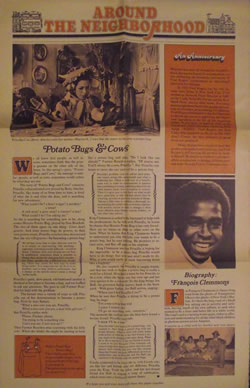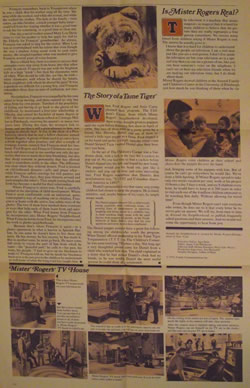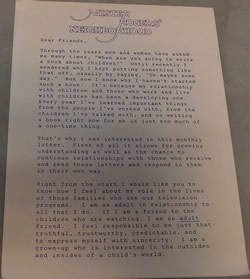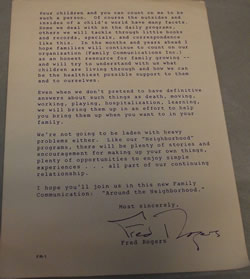Around the Neighborhood - Volume 1, Number 1
In 1973, Family Communications initiated a print newsletter titled Around the Neighborhood. This newspaper-like publication was largely directed towards parents but included some material for children as well. The information below documents the first issue.
Articles included:
- An Anniversary
- Potato Bugs & Cows
- Make a Paper Bag Potato Bug
- Biography: Francois Clemmons
- The Story of a Tame Tiger
- Is Mister Rogers Real?
- Mister Rogers' TV House
A Message From Fred Rogers
Along with this inaugural issue of Around the Neighborhood came a letter from Fred Rogers.
Dear Friends,
Through the years men and women have asked me many times, "When are you going to write a book about children?" Until recently I wondered why I kept putting something like that off, usually by saying, "Oh maybe some day." but now I know why I haven't started such a book. It's because my relationship with children and those who work and live with children has been a developing one. Every year I've learned important things from the people I've worked with, from the children I've talked with, and so writing a book right now for me is just too much of a one-time thing.
That's why I was interested in this monthly newsletter. First of all it allows for growing understanding as well as the chance to continue relationships with those who receive and read these letters and respond to them in their own way.
Right from the start I would like you to know how I feel about my role in the lives of those families who use our television programs. I am an adult in relationship to all that I do. If I am a friend to the children who are watching, I am an adult friend. I feel responsible to be just that: truthful, trustworthy, predictable, and to express myself with sincerity. I am a grown-up who is interested in the outsides and insides of a child's world.
Your children and you can count on me to be such a person. Of course the outsides and insides of a child's world have many facets. Some we deal with on the daily programs, others we will tackle through little books and records, specials, and correspondence like this. In the months and years ahead I hope families will continue to count on our organization (Family Communications Inc.) as an honest resource for family growing -- and will try to understand with us what children are living through and how we can be the healthiest possible support to them and to ourselves.
Even when we don't pretend to have definitive answers about such things as death, moving, working, playing, hospitalization, learning, we will bring them up in an effort to help you bring them up when you want to in your family.
We're not going to be laden with heavy problems either. Like our "Neighborhood" programs, there will be plenty of stories and encouragement for making up your own things, plenty of opportunities to enjoy simple experiences...all part of our continuing relationship.
I hope you'll join us in this new Family Communication: "Around the Neighborhood."
Most sincerely,
Fred Rogers
Articles
With this first issue of Around the Neighborhood, the newest Family Communication, we are celebrating the twentieth anniversary of Fred Rogers' commitment to educational television for children.
In 1953, Fred Rogers and his wife Joanne were living in New York City. Fred worked as Network Floor Director at NBC on the Lucky Strike Hit Parade and the Kate Smith Hour, among other shows. Becoming increasingly disturbed by the quality and content of television programming for children, Fred Rogers determined in April of that year to devote his career to improving this important ingredient in the life of the American public. A year later, in April of 1954, at the brand new public television station in Pittsburgh (WQED), Fred Rogers and Josie Carey first appeared on the air in The Children's Corner, the first children's program Fred ever produced.
Many changes have occurred since that decision was made twenty years ago, but Fred Rogers is still keeping the promise he made to himself. He and his co-workers continue to affirm a dedication to helping children grow and learn through Family Communications.

The story of "Potato Bugs and Cows" concerns Priscilla, a discontented cow played by Betty Aberlin. Priscilla, like many of us from time to time, is tired of what she is and what she does, and is searching for new adventures:
"What could I be? a lion? a tiger? a monkey? a wren?
A rich man? a poor man? a rooster? a hen?
What could I be? I'm asking me."
As she is searching for something new to be, along comes Horatio Potato Bug, played by Don Brockett. The two of them agree on one thing: Cows don't groove. And since potato bugs do groove, to their own groovy music, Priscilla soon becomes determined that she too will groove -- by becoming a potato bug!
We all feel, from time to time, that our own lot is so empty, so unpromising, that anything -- especially something totally different -- would be better. Children, their own identity not yet firmly established, sometimes think it possible to change their insides by changing their outsides -- new shoes, another toy, a different way of talking. Often that seems the best way to make things better. It is important for all of us to remember, and to help children understand, that a change on the outside doesn't mean a change on the inside.
Priscilla's quiet, slow-paced, old-fashioned mother is shocked at her plans to become a bug, and too baffled to ask any questions. She goes to call Farmer Reardon for help with the problem.
The farmer tries a variety of way to talk Priscilla out of her determination to become a potato bug. First he tries flattery:
"What a nice cow you are, Priscilla. What a nice cow you are, a dear little girl cow."
But Priscilla replies with:
"Please, Farmer, please, I'm trying to be something else. Can't you see. Can't you see?"
Then Farmer Reardon tries reasoning with the little cow: When she thinks she might be starting to look like a potato bug and asks, "Do I look like one already?" Farmer Reardon replies, "Of course not. You'll always be a cow, Priscilla." But Priscilla continues to insist she can and will be a potato bug.
Priscilla's problem won't be solved until someone comes along who understands just what is bothering her. Often a child acts in a troublesome way in order to communicate to parents that something is wrong, something that even the child doesn't know how to explain or correct. Then it is up to you to look back on what might have upset him, to talk with him about what he is feeling, in order to get to the bottom of things. Taking a little time to combine a thorough understanding of a child's fears or worries together with positive action to make a change is often more effective than flattery, reason, bribery, or any other easy answer.
King Clemmons. is called to the barnyard. to help with the predicament. As he talks with Priscilla, he learns by chance that Horatio Potato Bug is her only friend: there are no horses or sheep or other cows on the farm. When he learns that King Clemmons begins to understand just why this little cow wants to be a potato bug, but he says nothing. He promises to return soon, and flies off again in his airplane.
King Clemmons sees that Priscilla is hoping for the impossible: to be a potato bug Priscilla would have to do things that cows just aren't made to do. Why, a cow could easily get stuck burrowing down into a bughole!
He also suspects that Priscilla is simply lonely, and that her wish to become a potato bug is really a wish for a friend. How hard it must be for Priscilla to be a cow, when she has no one her own age and her own species to be a cow with! So the king brings Joe Bull, the grooviest bull he knows, back to the barnyard. with great fanfare, Joe Bull arrives, singing:
"Where can I find Priscilla Cow?"
When he sees that Priscilla is trying to be a potato bug, he sings:
"I've come a long long way, I guess I cannot stay. I'll go on searching now, somehow."
The moment she realizes that she may have found a bovine friend, Priscilla responds:
"I think I'll be a cow."
Priscilla didn't just want to be a potato bug -- she wanted to share being a potato bug with her friend Horatio. Often a child will come home with stories of what his or her best friend is doing, eager to be doing just the same thing. What he or she is saying is, "I like my friend so much, I want to be just the same." Your response can acknowledge how much you know they love and admire their friends, but you can also remind them that friends can share differences as well as similarities -- just a Priscilla and Joe Bull can continue to be friends with the potato bugs.
Finally contented to be what she is, with friends who are like her and friends who are different, Priscilla joins the King, Yoshi the pilot, and her new-found friend Joe Bull in singing a song of celebration, which turns into a farmyard square dance.
Use a small paper bag, draw colorful stripes on the back and front of the bug, if you want to. The potato bugs in the opera are pretend too.

Francois remember, back in Youngstown when he was a child, that his mother sang all the time. She sang while she cooked, and while she ironed, and while she washed the clothes. The kids in the family -- twin sisters, an older brother, a much younger baby sister -- could tell from her singing whether it was a good time to ask her for something, or a good time to clear out.
One day a social worker named Mary Lou Davis came to visit his mother to help her apply for Aid to the Elderly for Francois' grandmother. As always, Francois was asked to sing for the visitor. Mary Lou was so overwhelmed with his talent that even though she was a student doing social work to earn extra money, she scraped together what was needed to give Francois several years of voice lessons.
But to a black boy, there is a snare to success that entangles every step away from home into that other world. In school, Francois was put with the brightest kids in a high "track" -- but then his classmates were all white. Who should he talk like, act like, be with -- white classmates with whom he shared his future, black neighbors with whom he shared his past? It was a question too difficult for a young boy, and Francois remembers those days as ones of confusion, not resolution.
Nevertheless, Francois was compelled by his own talent to keep moving, and there seemed no way but away from his own people. Terrified of the possibility of failing and having to go back to the ghetto of his childhood, he maintained a four-year scholarship at Oberlin, and earned his bachelor of music degree in 1967. He went on to graduate school at Carnegie Mellon in Pittsburgh, receiving his master's in music two years later. During this time, his strongest link to home, and one that is still a great pleasure to him, was singing in church choir. It was in the choir of a Presbyterian church that he met a fellow chorister named Joanne Rogers. A group of them used to go out to have a drink together after practice, and after a couple of evenings Joanne insisted that Francois meet her husband. Fred Rogers and Francois Clemmons met over lunch and discovered in one another not only the mutuality that was to mark their firm friendship, but also that sharp contrast in personality that has allowed each to contribute richly to the other. The difference was clear when they ordered dessert -- jello and prune whip -- while Francois suffers cravings for rich pastries and pecan pie. These days, they pass desserts around and each samples the other's. That simple tasting back and forth has become a model for their relationship.
Where Francois is street-wise, Fred is carefully trained in the discipline of child development. Where Fred is most comfortable with an unhurried, quiet, contemplative way of reaching out to children, Francois is at home with the active, less subtle ways of the ghetto. The two of them have meshed these contrasts in ways that help each of them learn from and interpret for the other. What Fred learns from Francois he incorporates into Mister Rogers' Neighborhood. What Francois learns from Fred, he incorporates into his work in ghetto neighborhoods.
Because that's where Francois is again -- in a ghetto apartment in what is known as Spanish Harlem. In one sense he doesn't have to live there any more. He has money, he has success, he has made it. But in another sense, he must go back. He must come full circle to rejoin the part of him from which he came -- the "peaceful part," he calls it -- his past, his roots, his people. "I had to give up my blackness to make it," Francois told us, but he needs his blackness back now so he can give to the children he understands so well some of what the long road has taught him.

In the set of The Children's Corner was a line-drawn clock, with a hole in the face for a cuckoo to pop out of. No one had time to find a cuckoo before Daniel slipped into the hole and found his new home. The puppet would pop his head out, just like a cuckoo, and sing out the time and some interesting fact. Fred Rogers remembers that Daniel's first proclamation was, "It's 5:02 and Columbus discovered America in 1492!"
Daniel's personality is one that many very young children feel closest to among the puppets. He is timid, sensitive, and, maybe because of his voice, he simply seems small.
The Daniel puppet often acts like a child would, asking questions about confusing issues, expressing fears of abandonment or rejection, laughing and being excited in a childlike way. A child watching Daniel speak with adult figures, both puppets and people, in the Neighborhood of Make-Believe, may find his own questions answered, his own fears comforted.
The Daniel puppet seems to have a great fan following among the children who watch the program. When Daniel offered membership in his Tame Tiger Torganization (T.T.T.) on The Children's Corner, he was soon receiving 750 letters a day. Not long ago a very thoughtful present came for Daniel from a child who watched him often. The child explained in a letter that he had noticed Daniel's clock had no hands, so he was sending Daniel the most useful present he could think of -- a wristwatch.

I know that it is hard for children to understand about the people on television. I am a real man just like you are a real person. I don't live inside the television set but your television set is a special way that you can see a picture of me, like you can hear someone's voice on the telephone. I can't see or hear my television friends when we are making our television visits, but I do think about them.
Mister Rogers showed children at the Arsenal Family and Children's Center at the University of Pittsburgh just how much he was thinking of them when he visited, bringing some of his puppets with him. But of course he can't go everywhere he would like. We've done a little figuring. If Mister Rogers agreed to take only two weeks vacation per year, work at his project 10 hours a day 5 days a week, and see 8 children every hour, he would have to keep at it 200 years in order to visit each one of the 4 million children estimated to be watching him daily. Without allowing for travel time!
Even though Mister Rogers can't visit everyone who writes, he does see to it that every letter he receives gets an answer. We will try, from time to time in Around the Neighborhood, to publish frequently asked questions and their answers. And we would welcome the opportunity to hear from you.






Credits
Around the Neighborhood is created by Media Projects Incorporated of New York.
Executive Editor: Sara Stein
Editor: Susan Tyler Hitchcock
Editorial Staff: Hedda Sharapan, Mary Gale Moyes
Production Supervisor: Jim Macardell
Graphic Designer: Tobias O'Mara
© 1973, Family Communications Inc.




